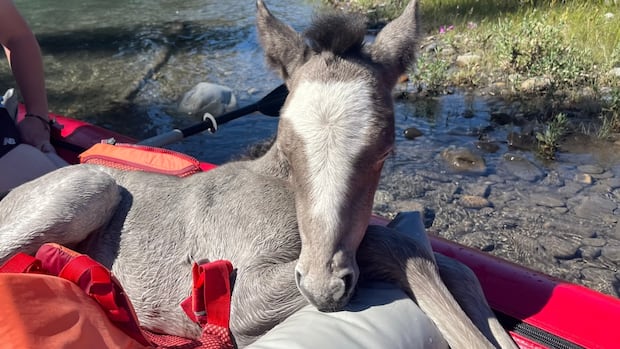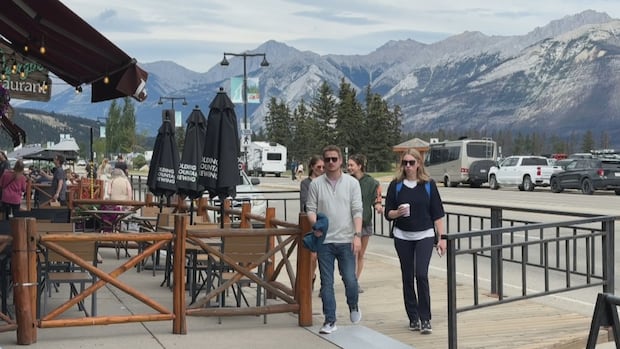Intrinsic to the Yukon River are skills shared and carefully honed among families, for generations.
Nika Silverfox-Young, a citizen of the Little Salmon Carmacks First Nation in the Yukon, calls this blood memory.
“We really travelled a lot and we used the rivers as our highways. We really needed them,” she said. “We’d pick out the best parts, and listen to the land when the salmon were coming back.
“We’ve lost that ability to listen to what our land is telling us. She is screaming right now about how we need to protect her.”
Silverfox-Young said the river is “part of me.”
“I feel like I’m legally, genetically obligated to protect this land … I want that to continue.”
Silverfox-Young is among a growing number of people who think it’s time the Yukon River had more significant environmental protections — in part, by granting the waterway legal personhood.
It’s an idea that already has the support of the Council of Yukon First Nations, and Alaska Native people, whose cultures are also intertwined with the river.
In the face of climate change, industrial impacts and imperilled salmon populations, advocates are now calling for dialogue and cooperation, among communities along the river and all levels of government.
Efforts often stem from ‘long-standing disputes’
There’s precedent in Canada for granting environmental personhood. The Innu of Ekuanitshit and a regional municipality in Quebec granted the Magpie River with the status in 2021, to primarily defend it against hydro development. A resolution grants the river nine rights, including the right to flow, the right to maintain its biodiversity and the right to be safe from pollution. It even has the right to sue.
Calls for environmental personhood are mounting in B.C., too.
In October, the British Columbia Assembly of First Nations passed a resolution calling on the province and others to work with First Nations to advance the legal personhood of nature, “including water bodies such as rivers and lakes, forests and mountains within a First Nations’ unceded traditional territory.”
And in New Zealand, after more than a century-long fight led by Māori to protect the Whanganui River, the country’s parliament passed legislation in 2017 that granted the waterway fundamental rights that build in Indigenous cosmologies — the first of its kind in the world.

There’s a common dominator to every effort to assign legal personhood to entities found in the natural world, said Stepan Wood, professor at Allard School of Law and the director of the Centre for Law and the Environment at the University of British Columbia.
“They arise out of longstanding disputes or claims of treaty violations,” he said, noting the case of the Whanganui River.
“From the beginning, one of the core demands of the Māori was ‘land back,’ which is again a similar, you know, refrain,” he said, referring to the Indigenous-led movement to reclaim Indigenous jurisdiction.
Trouble was, Wood said, the New Zealand parliament was dead-set against allowing Māori ownership of the land. So, a compromise was struck.
The idea was to legally define those connections, steeped in Māori law and cosmology — nature as a group of ancestors.
Legal personhood hinges on local contexts, and it needs to be customized accordingly, Wood said.
“There’s no one-size-fit-all approach,” he said.
“One of the similarities with Canada is that you have 150 years of systematic violation of treaty promises by the British Crown and, you know, dispossession of Indigenous peoples and total negation of their laws and their jurisdiction and their sovereignty.”

As for how this could be applied in the Yukon, Wood said that’s likely to be an open question for some time.
“Would the goal be to have laws adopted by the self-governing nations, so within either they’re delegated or they’re inherent self governance authority? Would it be territorial legislation or federal legislation?”
Wood also said it could take the form of a transboundary Indigenous treaty.
“Kind of like a treaty amongst the various First Nations up and down the Yukon River saying we are all in agreement that the Yukon River is a, you know, a living entity, with spirit.”
‘The water, to us, is life’
In March, a majority of member nations belonging to the Council of Yukon First Nations (CYFN) voted in favour of looking into legal personhood for the Yukon River.
Made up of two parts, the resolution also calls on the territory to support both short- and long-term management plans of the river’s corridor, which includes banks and channels — land integral to the waterway. Linked to that, the missive urges the territory to consider legal personhood “for the entirety of the Yukon River Corridor with all affected First Nations.”
Erin McQuaig, the deputy chief of the Tr’ondëk Hwëch’in First Nation in Dawson City, Yukon, said legal personhood would elevate needed protections for the river.
“The water, to us, is life. It gives life to every living form on earth and it should be recognized as such,” McQuaig said.
McQuaig said this work corresponds with efforts to save chinook salmon, whose numbers in the Yukon River have declined precipitously for years and have been plunged into a deep crisis.
“It’s imperative for us as people to continue and also reclaim our culture. We have many, many young citizens that have never seen a salmon come out of the river where we live.”

Premier Ranj Pillai addressed CYFN’s resolution last week in the legislative assembly. He said he knows it’s important to protect the river, but that his government hasn’t contemplated environmental personhood.
“To be very open, I don’t have enough of a breadth of understanding of just what this would mean from a policy perspective and legally, but I know that we’ll continue to work with Tr’ondëk Hwëch’in … and we’ll be speaking with the Council of Yukon First Nations on the resolution,” Pillai said.
Whitehorse dam relicensing sparks talk
Pillai said conversations about legal personhood in the territory have stemmed from work on a regional land use plan in the Dawson area. Buried in the recommended plan released in 2022, the planning commission also floats legal personhood.
But the concept has been raised in the territory’s south for years.
The Yukon’s largest hydroelectric dam, in Whitehorse, has been moving through the relicensing process. While the facility provides crucial electricity — meeting about 75 per cent of the territory’s demand in the summer alone — it’s come under intense scrutiny at times for its impacts on Yukon River salmon. This is the first time the dam has been reviewed by the Yukon Environmental and Socio-economic Assessment Board (YESAB).
During the assessment phase, the Ta’an Kwäch’än Council raised the prospect of granting legal personhood to the Yukon River.
“To date, there has not been consideration given to the Yukon River as a natural person, complete with rights, nor has there been gratitude expressed for the electricity it has given to us,” the First Nation states in a 2023 submission to YESAB.
While the board ultimately did not address the idea of environmental personhood in its assessment of the dam, a spokesperson told CBC News that, “YESAB’s process enables future dialogue on this emerging topic within Yukon.”
Catherine Ford-Lammers, the lead on the Whitehorse dam relicensing for the Carcross/Tagish First Nation, said her community is also interested in environmental personhood and looking at what’s worked elsewhere.
“It does need to be looked at, but then I guess it could come with its own set of complications in terms of who are the parties to manage that personhood for the Yukon River,” Ford-Lammers said.
Nicole Tom, former chief of the Little Salmon Carmacks First Nation, now serves as a mentor and advisor for Yukon-based To Swim and Speak with Salmon, an Indigenous-led conservation organization that empowers youth.
No doubt, she said, the process would be complex, with no shortage of legal wrangling and politics.
But Tom said it’s necessary to wade into that world — threats to freshwater are too great to ignore anymore. Case in point, she said, the Eagle Mine failure that sent shockwaves across the territory and continues to roil people who live in the region.
“Those conversations are not far-fetched, and when you have political alignment that’s when you can really see some changes for the good,” Tom said.
“It’s necessary with climate change, it’s necessary with everything that’s going on right now that these special water systems be protected.
“It’s a means of survival and it’s a means of cultural identity.”
A transboundary river coalition
There are dozens of communities along the Yukon, the third-longest river in North America. Like those communities, the river is also diverse — the waterway braids, riffles and plumbs to great depths near Lake Laberge.
Mackenzie Englishoe, youth advisor for Alaska’s Tanana Chiefs Conference, a tribal consortium of 42 villages in the state’s interior, wants a transboundary coalition formed within five years to help unify communities. Englishoe, who’s Gwichya Gwich’in, believes this would further galvanize people to speak up and act.

“I think that would include lobbying, educating ourselves — our people — and outside communities about our relationship to the river, and respect for the river. I think this would establish key protections and help our salmon. It would help all animals and the people along the river,” Englishoe said.
“My identity as a person is, I have to look at this river as something that’s taken care of me, and has sacrificed for me, and I have to do the same for her.”
Jared Gonet, director of To Swim and Speak with Salmon, said the first step is decolonization.
He said the idea isn’t to consider rivers as people, so much as living entities that hold entire ecosystems together — communities, too.
“I’ve heard Kaska Elders speak about, like, mountains, rivers, headwaters as beings having their own agency,” Gonet said.
“For me, the biggest challenge is going to be just talking, getting the time, the resources, the people, those bright minds to come back and start, you know, really pushing and talking and engaging people.”

Wood, the law professor, said environmental personhood can shift paradigms, changing for the better people’s relationship to the natural world.
“So, changing it from nature being a collection of objects to be owned and exploited by humans, through nature as a community of older, more senior relatives to be revered and respected by humans,” he said.
“The ultimate question is how can the settler colonial legal and political system make room for the expression of Indigenous law and jurisdiction.”






